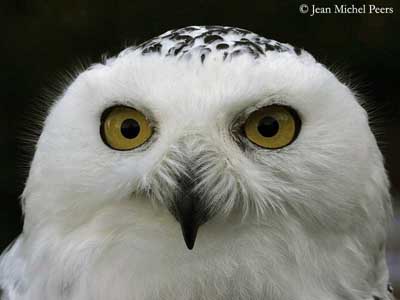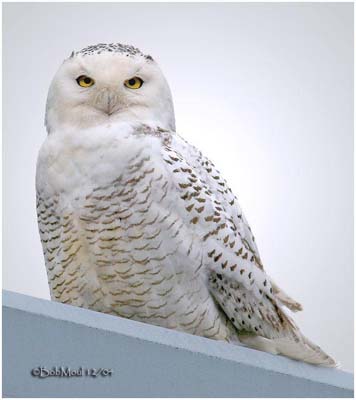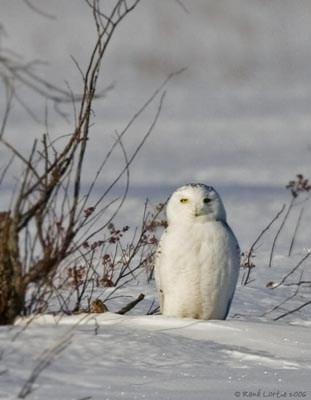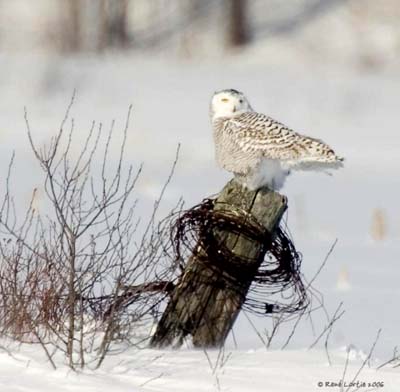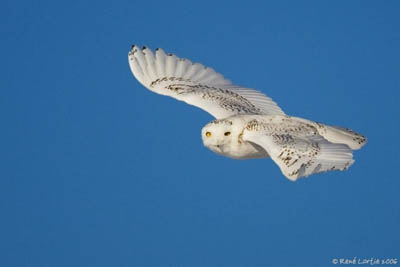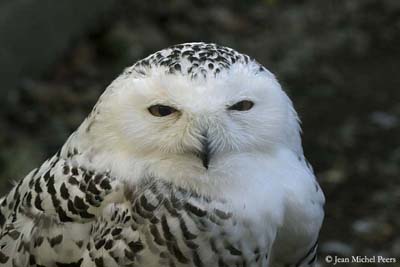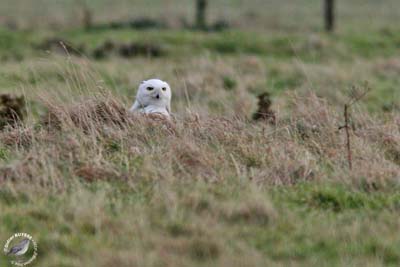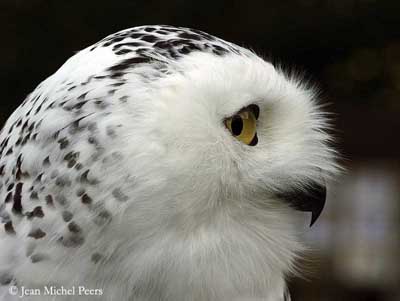
Snowy Owl
Bubo scandiacus
Strigiforme Order – Strigidae Family
BIOMETRICS:
Length: 53-66 cm
Wingspan: 142-166 cm
Weight: 1130-2000 g (M : 1600g ; F : 1700g)
LONGEVITY: up to 10 years in wild
DESCRIPTION:

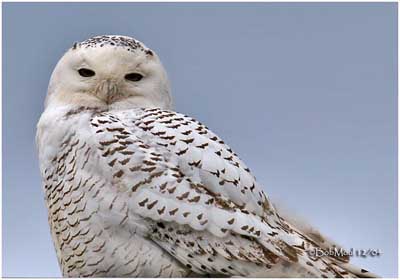
Snowy owl is a large diurnal Owl, with fairly rounded head, yellow eyes and black bill. Feet are well feathered. It is a distinct white Owl, which entire plumage may be variably streaked or mottled, with black horizontal streaks or spots. It has facial disks with stiff feathers around eyes, reflecting sound waves towards ears.
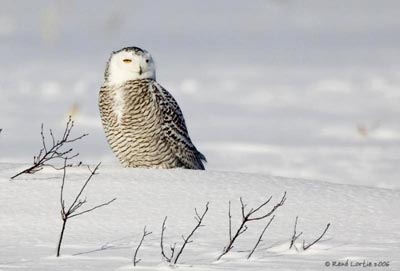
Females and juveniles are more streaked than males. Those may be pure white, although they have at least three tail bars. Adult female is neatly streaked, and black spots may be equals or dominant compared with entire body plumage.
Intensity of black spots varies with sex of immature, female being darker than males. They are about 20% larger than males.
Juveniles are brown, with some sparse white down.
It may live up to 35 years in captivity.
VOICE: SOUNDS BY XENO-CANTO
Snowy Owl is usually silent out of breeding season. During this period, male utters a loud and booming “hoo-hoo” as an alarm call or in courtship display. Females rarely ululate. Its attack call is a guttural “krouff-gouh-gouh-gouk”. When excited, it utters a loud “hoou-uh, hoou-uh, hoou-uh, wuh-wuh-wuh”.
Other sounds resemble barks, crackles, loud calls, whistles and bill snapping. Nestlings peep at two weeks of age, and then, they whistle or chirp.
HABITAT:
Snowy Owl is a bird from arctic tundra, grassy open areas and fields. It rarely goes into forests. When it migrates southwards, we can find it along lake shores, sea coasts, swamps, and sometimes, it perches on buildings in town.
In Arctic, it perches on pingaluks (iced snow hummocks), very numerous in tundra. It nests at low level from valleys to mountainous areas and high plains, at up to 1000 metres of elevation.
When it winters in arctic, it frequents tundra swept by winds with few snow and ice. Southwards, it can be found mostly on cultivated areas.
RANGE:
Circumpolar arctic
BEHAVIOUR:
Snowy Owl hunts with the “wait and sit” tactic, turning head up to 270 degrees (because its eyes don’t turn into sockets, which obliges it to turn the head), to look around and search preys. It often hunts at dusk, but also during the day.
Preys are captured on the ground and in mid air, or caught on the surface of the water.
When it captures a hare, it thrusts its claws into animal’s back, and strikes it until it dies. It seizes it by neck with the bill to carry it. Small pieces are swallowed whole, while larger are brought and teared in large bits.
Young are fed with flesh without bones and fur. Large preys are brought in the claws, and others, as lemmings, with the bill.
Snowy Owl depends from lemming populations and voles, and it may disperse according to food resources. It doesn’t hunt near the nest, so, other birds as Snow Goose, often nest close to it, because Snowy Owl drives away predators from this place.
Snowy Owl ejects big and unequal cylindrical pellets including numerous bones, feathers and fur. They are ejected on roost sites, under perches, where we can find a lot of them at the same time. When a prey is swallowed into small bits, there is not pellet.
Courtship display starts in mid-winter until March-April, very far from nesting areas. Male performs an undulating flight (as moths) when female is visible. On the ground, it bows, with ruffled feathers, and it struts around her, with fanned wings until the ground. Male hunts and displays its preys to impress female, and performs courtship feeding.
REPRODUCTION:
Snowy Owl nests exclusively on the ground, where female digs out a shallow depression with its claws, at the top of a hummock or a rock. Abandoned Eagles nests may be used. Nest may be lined with vegetation pieces and feathers. Nest site has to be close to good food resources areas, without snow and offering o good view all around. Sometimes, pair may nest on the same place years after years. Territory around the nest sizes about 1, 5 to 6, 5 squared km, and may be shared with other pairs. Reproduction depends from food. Snowy owl doesn’t breed if lemming populations are not sufficient.
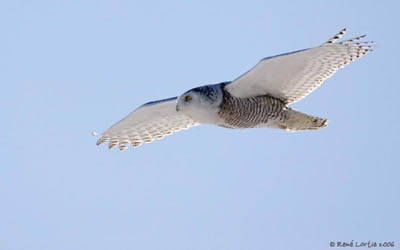
Female usually lays 5 to 8 white eggs, but possibly up to 14 eggs when lemmings are abundant. She laid the eggs every two days. Incubation lasts about 32 to 34 days, by female. Male feeds her and surveys the nest site. Chicks hatch every two days. They are covered with white down. They begin to leave the nest at about 25 days of age, before to be able to fly. They get their plumage at about 50 to 60 days. They reach their sexual maturity when they are 2 or 3 years old. Both parents feed and take care for them, and they are aggressive against all intruders until one kilometre from the nest. An entire Snowy Owl family may consume until 1500 lemmings before young disperse.
This species produces only one brood, even it is lost. Years with a lot of food, there is usually 100% nesting success.
DIET:
Snowy Owl depends from lemming and vole populations on winter areas. It consumes a large variety of mammals, mice, hares, skunks, marmots, squirrels, rabbits, moles and all bringing fur!
It also feeds on birds, geese, ducks, waders, pheasants, grebes, gulls, small birds and other small nocturnal raptors. It may consume fish and carrion.
PROTECTION / THREATS / STATUS:
Snowy Owl has few predators. They are artic foxes and wolves, which capture them on breeding areas, while Skuas take eggs and nestlings.
There also are vulnerable to collisions with electric wires, fences, vehicles, especially for wintering birds in southern Canada.
Fr: Harfang des neiges
All : Schnee-Eule
Esp : Búho Nival
Ital: Civetta delle nevi
Nd: Sneeuwuil
Russe: Белая сова
Sd: Fjälluggla
Text by Nicole Bouglouan
Photos de René Lortie
Son site : http://rlortie.ca/
Photographs by Jean Michel Peers
His website : JMPN PHOTOGRAPHIE
Photographs by Bob Moul
His website: Nature Photography
Photographs by Didier Buysse
His website : Vision d’Oiseaux
Sources :
HANDBOOK OF THE BIRDS OF THE WORLD Vol 5 by Josep del Hoyo-Andrew Elliott-Jordi Sargatal - Lynx Edicions - ISBN: 8487334253
All About Birds (Cornell Lab of Ornithology)
Wikipedia (Wikipedia, The Free Encyclopedia)
Animal Diversity Web (University of Michigan Museum of Zoology)
